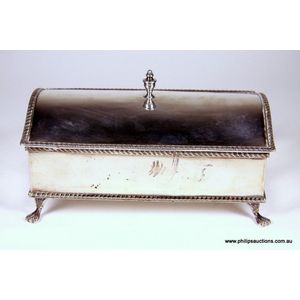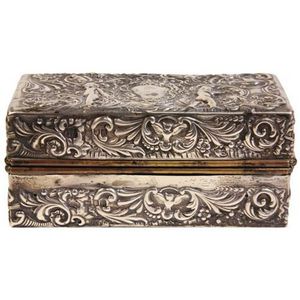Edwardian Silver and Tortoiseshell Pique Jewel Box
You must be a subscriber, and be logged in to view price and dealer details.
Subscribe Now to view actual auction price for this item
When you subscribe, you have the option of setting the currency in which to display prices to $Au, $US, $NZ or Stg.
- Tortoiseshell - Tortoiseshell is a translucent material that comes from the horny carapace of a certain types of turtles, including the hawksbill turtle. It is often therefore mounted on a colour underground - often red - or inlaid with gold or silver thread, as seen in Boulle furniture.
The texture and colour nuances of the material are extremely important. Heated tortoiseshell can easily be formed into various shapes. Like other natural materials, tortoiseshell becomes more beautiful with use. In a time before plastic, tortoiseshell was widely used for small objects such as combs and powder compacts.
In 1973, the trade of tortoiseshell worldwide was banned under CITES (The Convention on International Trade in Endangered Species). Prior to importing or exporting items containing tortoiseshell a CITES permit must be obtained. Tortoiseshell items cannot be traded on Ebay.
"Faux tortoiseshell", another case of man initiating nature, is made from old-style plastics such as celluloid and cellulos and is coloured with red, yellow and brown spots to imitate the genuine article. It is commonly used in glasses frames, musical instruments and costume jewellery. - Pique Work - A decorative technique used on jewellery and small decorative objects in which designs are created by inlaying small gold or silver studs and stips into tortoiseshell. The art reached its highest point in 17th- and 18th-century France, particularly for the decoration of small tortoiseshell articles such as combs, patch boxes, and snuffboxes.
- Edwardian - The Edwardian period of English furniture and decorative arts design is named for Edward VII (1841 ? 1910) who was King of the United Kingdom and the British Dominions and Emperor of India for the brief period from 1901 until his death in 1910. It follows the Victorian period, in turn was followed by the Art Nouveau and Art Deco styles. In Australia, designs of this period are also known as being in the Federation style.
This item has been included into following indexes:
Visually similar items

A silver plated inkwell, raised on putti feet, marked Sheffield. Length 25.5 cm.

A copper repousse twin handled elongated jardiniere, French, 18th/19th century, 26 cm high, 98 cm across the handles

A Victorian Sheffield plate desk set, 19th century, the casket-styled box with a domed lid and urn form finial with lion ring handles to the sides, raised on lion's paw feet, with gadroon edges throughout, the interior with a fitted compartment with two gl

English hallmarked sterling silver Victorian travelling ink well decorated with raised putti and birds, with a silver plated insert marked 'Electroplate Paris' London, 1896, maker Goldsmiths & Silversmiths Co dimensions 10.5 x 5.5 x 4 cm
